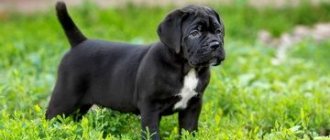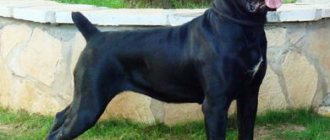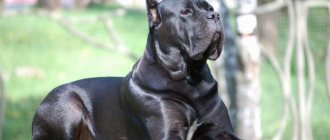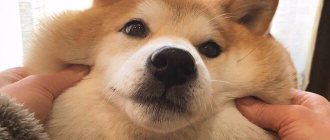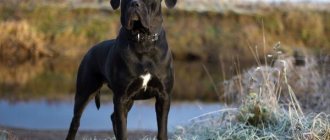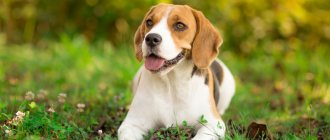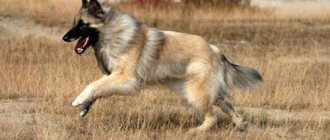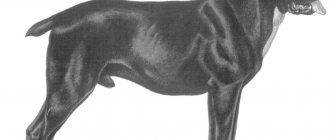Breed characteristics
| Short description | |
| Origin: | Italy |
| Conditions of detention: | House without garden, house with garden, apartment |
| Purpose: | Guard dog, herding dog |
| Color: | Black, brown, brindle, fawn, black mask acceptable |
| Wool length: | Short |
| Adult dog size: | The height of females is 60-64 cm, males 64-68 cm, weight of males is approximately 45-50 kg, females - 40-45 kg |
| Average life expectancy: | 10-12 years |
| Walk: | Mandatory walk 2 times a day |
| Physical activity needs: | High physical activity needs (regular or daily exercise for more than 3 hours per day) |
| Fédération Cynologique Internationale (FIC) classification: | Group 2: Pinschers and Schnauzers, Molossians, Mountain and Swiss Cattle Dogs; Section 2: Molossians |
| Puppy price: | From 12,000 to 50,000 rubles. Without pedigree – 12,000-15,000 rubles, pet class – 20,000-25,000 rubles, breed class – 30,000-40,000 rubles, show class – 50,000 rubles |
Health and illness of the Cane Corso
Cane Corso is a powerful and strong breed of dog; the animal's life expectancy is 9-11 years with proper care and maintenance. However, this breed often suffers from joint disease. Their musculoskeletal system may not develop properly, and the disease can be diagnosed as early as one and a half years of age. The first signs of the disease are lameness, fatigue, and crossing of the limbs. In order to avoid illness, it is necessary to properly feed, control the weight and physical activity of the animal.
Frequent diseases:
- joint dysplasia;
- bloating;
- eversion or inversion of the eyelid;
- heart diseases.
Dog vaccinations are given on schedule; these are extremely important procedures and should not be skipped. It is also necessary to regularly treat the animal against fleas, ticks and worms.
History of the origin of the species
The Cane Corso is an ancient breed that originates from the Molosser family, the ancient Roman gladiator dogs. The remains of similar animals were found in southern Italy and date back to BC.
In 1238, the coat of arms of the aristocratic family of De Corsi depicted a dog with similar features to the Cane Corso. This image was considered a symbol of masculinity, power, and courage. Although this breed was considered a domestic breed, unsuitable for secular society, its maintenance was honorable. Selection work was carried out randomly, so even in one village there could be individuals of different appearance and character.
The Cane Corso was often described by Italian poets and writers in their works (15-16 centuries). Teofilo Folengo tells of a bear and lion hunt during which Corso was wounded and killed. And during the Renaissance, these dogs were depicted by artists, admiring their muscles and structure. In addition, there are many proverbs associated with this breed.
As for the name, no one knows for sure why pets have this particular name. It is believed that the breed was formed on the island of Corsica, Conrad Gessner wrote about this in his work on “quadrupeds”.
Another version is completely unrelated to the island and the dogs’ habitat. From Latin, Corso is a watchman or guard, and Cane is a dog. From Greek, Corso means property surrounded by a fence . So it turns out, a dog protecting fenced property.
These pets served in all spheres of the peasants' working activities: they herded cattle, drove bulls, hunted, looked after children, and were indispensable in agricultural life. That is why, after the Second World War, during the active phase of industrialization, the number of dogs began to decline.
But Italian enthusiasts, led by Breber, decided to restore the breed line, selecting the most purebred individuals, and received the first standard - the dog Bazira . In 1984, Antonio Morsiani wrote the first breed standard. Cane Corso were recognized recently - in 1994.
Historical reference
The history of the appearance of the Cane Corso breed is associated with Ancient Rome.
Its ancestors are considered to be Molossian dogs, descended from the fighting dogs of Persia and Carthage, the mastiff-based breeds of Macedonia.
Ancient dog breeders specially bred this breed for guard and combat service, and therefore special attention was paid to its large size, devotion and lack of fear..
In addition to military specialization and gladiator fights, dogs took a worthy part in hunting large animals (even lions).
Along with the decline of ancient Roman civilization, Cane Corso also fell into disgrace.
The new nobility considered her insufficiently aristocratic and rustic. As a result, the dog ended up in the provinces and rural settlements, where they did not care about the purity of the breed. Previously, a single breed, due to various arbitrary mixings, was divided into several subspecies, losing many of its characteristic features.
Interest in the Cane Corso was restored by the Italian researcher and passionate dog lover Breber..
Only in the early 90s of the last century was he able to interest professional dog handlers and prove the right to exist of this breed as an independent species.
In November 1996, this status was officially approved. In 2003, the breed standard came into force.
The undeserved oblivion ended, and the Cane Corso became the pet of politicians, businessmen, and artists..
Distinctive features
The Cane Corso is a medium-sized dog with well-developed, defined muscles. The format is elongated, the length exceeds the height by 11%. Outwardly he looks strong, graceful, confident. The coat is short, shiny, and lies close to the body.
The last standard was published in 1999. According to it, all dogs that do not meet the standards of behavior and external characteristics are discarded.
- The head is wide, square, small and shallow. Convex cheekbones . The brow ridges and frontal sulcus are visible Characterized by fleshy folds of skin on the forehead and near the lips.
- The muzzle is not long (4/10 of the length of the skull), but wide and voluminous. The bridge of the nose is straight. The jaws are strong, powerful, the upper one is slightly shorter, “undershot” type bite The lips are drooping, the upper one overlaps the lower one and forms an arch. Pigmentation is black.
- The nose is straight, large with open wide nostrils, black.
- The eyes are medium in size, set quite wide and deep (under the overhanging eyebrows). The eyelids are fused at the corners and have bright black pigmentation. The color of the iris is dark, almost black.
- The ears are large, set high, with a wide base. It is customary to cut to an equilateral triangle; otherwise, they hang down on the sides of the head and reach the cheekbones. Covered with short thick hair.
- The body is strong, elongated, with developed muscles. The back is straight and wide, slightly raised towards the neck. The loin is short and strong, slightly arched. The croup is slightly sloping. The chest is wide (35% of the height at the withers), deep (reaches the elbow joint), and protrudes forward. The ribs are rounded. The neck is muscular, equal in length to the head, arched, oval in cross-section. There is no suspension. The belly and hemline are well defined.
- The tail is long (below the hocks), thick at the base, tapered towards the end. Set below the lumbar line, lowered when calm. When active, it does not rise above the croup, but may bend slightly. It is customary to dock at 2/3 of the length.
- The limbs are straight and parallel, perpendicular to the ground, and have a straight posture. The muscles and bones are well developed. Paws are oval (the hind legs are slightly elongated); with fingers clenched into a ball. The pigment of the claws is black. The movements are like a trot, a little stretched out.
- The skin is thick, but fits tightly to the body, forming folds on the head and muzzle.
- The coat is short, flat, thick, lying close to the skin. There is undercoat, but not long (up to 2 cm).
- Colors: black, gray, tan, red, brindle. In red and brindle cats, a black mask is acceptable, and small white spots on the chest, paws or bridge of the nose are also allowed.
History of the Cane Corso breed
This breed has an interesting and long history. Even in ancient times, there were Tibetan Great Danes; they are considered to be the distant ancestors of the Cane Corso. Then these dogs played an important role in protecting people, saving them from enemy attacks.
The first Tibetan Great Dane was presented to the Chinese Emperor, who spread the breed. Such dogs were bred for the purpose of catching enemies and protecting people. In the Roman Empire, these dogs took part in dog fights, were used for military purposes and acted as guards.
After the fall of Ancient Rome, Cane Corso began to be crossed with Celtic greyhounds, which slightly changed the characteristics of the breed. Dogs began to be used as guards and also for hunting. Thanks to this, the basis of the positive qualities of the breed is devotion and loyalty to one owner.
Cane Corso have been valued since ancient times, the duration of their lineage was well monitored, but even this did not affect the fact that the animals were on the verge of extinction during World War II. They were used as helpers in the war, the dogs were malnourished, this greatly affected their numbers.
However, the dogs were saved from such a fate, thanks to Giovanni Bonatti Nizzoli. He, together with like-minded people, gathered all the purebred dogs and already in 1987 they were officially established in the breed standard. The document contained a detailed description of the Corso and how they differ from their descendants. Tribal registration was obtained in 1994. After the official confirmation of the breed, the number of these individuals began to actively grow.
Interesting! In 1996, the Cane Corso received the title of winner at the international dog show!
Photo of an adult dog
First 4 years
The weight of an adult dog already reaches 45 kg for females and 55 kg for males.
As a rule, the first mating is carried out during this period. After it, the males again try to take leadership positions, but this time not within the family circle, but among other dogs. Thanks to their strength, Cane Corsos can cause great harm to other pets with whom they previously played during a walk. Under no circumstances should a dog be allowed to assert itself in this way.
Similar article: The most common and rare Cane Corso colors
The dog’s character can be adjusted up to three years of age, but the older he gets, the more difficult it is to do this.
Photos of puppies
Development from 1 to 12 months
A Cane Corso puppy eats and sleeps for up to two weeks. On the 12th day his eyes open.
At the age of three weeks, the puppy is confident on his feet and can eat porridge food, but the bond with his mother is still very strong.
At 4-7 weeks, babies develop conditioned reflexes, which means they are ready for training and learning. By this age, the puppy’s weight should be 6-8 kg.
If you do not adapt it during this period, in the future it can cause problems in the dog’s relationship with the outside world.
2-3 months is the ideal age for weaning a puppy from its mother; at this time, the baby is actively learning about society and he needs to see the diversity of the world around him.
The puppy becomes very inquisitive and studies the situation all the time . When meeting a stranger, he trustingly runs up to him to study him. At this age, it is imperative to teach your baby basic commands.
A male weighs 12-14 kg, a female – 10-13 kg.
4-6 months. The puppy is aware of the hierarchy in the family, so it is very important that all family members, including children, become leaders for the dog.
The weight of a male is 27-32 kg, that of a female is 25-28 kg.
Puberty occurs before 8 months, and the puppy tries to assert itself . He may ignore commands that he has always strictly followed.
The owner must be persistent, but not aggressive, to eliminate the possibility of disobedience. This is the final stage in the formation of subordination.
The weight of a male is about 40 kg, that of a female is 35 kg.
Up to 14 months, a Corso puppy may experience fear - it may be frightened by a sharp sound or an unfamiliar object . The dog owner must be patient and calm, explaining to the dog that there is no danger.
By this age, males weighing up to 46 kg and females weighing up to 43 kg can behave like small and naive puppies.
Features of character and behavior
Cane Corso are true Italians. They are not characterized by strict aristocracy; these dogs are playful, cheerful and active. They are loyal, balanced and reserved. Many people believe that they are to some extent phlegmatic.
These dogs are absolutely not aggressive, but remain good watchdogs and defenders of the territory.
Corsos truly have an impressive appearance and can even strike fear into passers-by and strangers. But these pets feel their strength and will not be able to harm even unintentionally. Most owners have no complaints about the breed, but there are pitfalls everywhere.
Video – Cane Corso with a child:
Advantages
- The qualities of security guards are in Corso's blood. They do not need special training. These dogs have a strong territorial instinct and will protect anything their owners entrust to them. They clearly distinguish between dangerous and safe people and animals, and are not inclined to show aggression and attack first. In addition, they will only give their voice at the most necessary moment, and in an emergency they are able to think and decide independently.
- Infinitely devoted to family. All Cane Corsos are monogamous and will not fawn or play with strangers. Children are not just friends for these dogs. These pets will protect them from any danger, endure all bullying, and will never offend them even unintentionally. Corsos are perfectly aware of their size, so they are quite careful during games. Stranger children are treated no worse.
- They are quite phlegmatic, do not often show emotions, but have bright facial expressions . They are indifferent to animals, they can get along with both a cat and a parrot.
- Smart and obedient, easy to train . They do not strive to take a leading position in the house, and will not manipulate the owners. Corsos are unobtrusive, they will happily play with their household, but will not bother you or get in the way.
Reviews about the Cane Corso dog
Reviews mention positive aspects more often than negative ones . Owners and breeders vying with each other to say that Corso is one of the best family dogs, with whom it is not only not scary, but also cozy.
- Alexandra Zhigun, the owner of the Cane Corso, speaks of her this way: “The best dog in the world, recognized as the best and smartest bodyguard. Agile, friendly, reliable and calm.”
Review from the Cane Corso owner from the dog forum:
Flaws
There are practically no temperamental defects in Cane Corso dogs. But to each his own.
- Definitely, such a pet will not be suitable for those owners who are inactive or do not have the time and financial resources to maintain it. In addition, it is necessary to take into account physiological features, for example, strong salivation and snoring.
- Corsos can be stubborn; girls are often capricious or picky when choosing food . With illiterate upbringing and lack of socialization, a dog can become aggressive towards strangers.
- Without proper physical activity, she will become too active at home . These pets love to try everything “by tooth”, especially in puppyhood.
- It will become a real nightmare for anyone who invades the territory. Corso cannot tolerate strangers who cross the boundaries of a property gate or apartment threshold without permission. There will be no ceremony.
- Indeed, it is rare to find negative reviews about this breed . Most often, a dog brings negative emotions because it does not meet the owners’ expectations (if they wanted a sofa decorative dog) or because of excessive drooling.
One of the owners points out that the breed is wonderful, but without proper socialization it will be wary of everything that moves; also complains of drooling.
Pros and cons of the breed
The main advantages and disadvantages of the breed are:
| + | – |
| It easily gets along in a private house - in the yard, enclosure, apartment. | Can be overly suspicious of strangers and can attack for no reason |
| Developed security and protective qualities | Without training, it is a danger to others |
| Devotion, fidelity | Phlegmatic, laziness |
| High intelligence, quick wit | Slobbery |
| Sensitivity to children. For a child living together, can be a friend, nanny | Requires a serious approach to the choice of nutrition, must eat nutritiously, high-quality products. |
Care and maintenance
The Cane Corso is not a particularly large dog, so it can easily get along in an apartment. Suitable for outdoor keeping only in very warm climates; due to its short coat, it does not tolerate frost well.
The dog practically does not smell, but actively sheds in the off-season. Care, like all mastiffs, includes regular walks, hygiene procedures and proper balanced nutrition.
Before purchasing a puppy, you need to take care of equipping him with a sleeping place. You also need to buy bowls on stands, toys, and hygiene products.
Nutrition
Cane Corsos can be unpretentious in their choice of food, but they can also be capricious. It depends on the personal qualities of each individual. The breed is prone to allergies to certain foods, so it is worth taking seriously the development of a personal diet.
- Cane Corso eat a lot, about 800 grams of food per day.
- Puppies are fed 3-4 times a day, and adults - 2 times.
When feeding naturally, the basis of the diet (50%) should be lean chicken, beef and rabbit meat. In addition, Corso needs to be given sinews and cartilage. The menu should also include other useful substances:
- Cereals (30% of the diet);
- Vegetables and fruits (except potatoes, melons, tomatoes and citrus fruits);
- Eggs;
- Dairy products (kefir, cottage cheese).
If the puppy was fed dry food in the kennel, then the transition should be made gradually or left with dry food. In this case, you should choose only among super-premium holistic products (grain-free).
You should not feed your pet human food, allow him to eat from the table or lick the plates. Clean drinking water should always be freely available. From childhood, vitamins are added to the puppy.
Health
Corsos are original dogs, they developed with virtually no human intervention. But due to various numerous breed lines, they acquired certain diseases that are characteristic of almost all individuals.
Breeders complain about the dogs’ sickness and short life, although according to the Cane Corso standard they can live up to 12 years . These dogs need to be carefully monitored, especially their exercise and diet.
With proper care and timely contact to a veterinary clinic if symptoms of any disease occur, the risk of losing your pet is minimal . Regular vaccination of puppies and adults plays a particularly important role.
Vaccinations
Vaccination of a puppy is the key to its strong immunity and health. The first two vaccinations are usually carried out in a nursery, where a veterinary passport is obtained. All medications are included in the document (name, date).
Every dog requires two basic vaccinations:
- Complex (enteritis, parainfluenza, plague, leptospirosis, salmonella) is done at 1.5, 2, 6, 12 months and annually;
- Anti-rabies (required for taking your pet abroad) at 7 months and every year.
All vaccinations are carried out in special veterinary clinics by trained doctors. Before the second vaccination, walking the pet is prohibited; before the procedure, the dog’s temperature must be measured (even minimal deviations are unacceptable) and disinfected against worms.
Sick pets, pregnant and lactating females, and male dogs after mating are not allowed to be vaccinated.
Diseases
This breed is prone to various diseases of the musculoskeletal system. The worst of them is hip dysplasia; it is inherited and practically incurable. You can prolong and improve the quality of life of your pet with the help of medications; some resort to solving the problem surgically. One way or another, the disease can be avoided if you do not overload the dog’s hind legs.
Often there are problems with the eyes - entropion of the eyelid, cherry eye, conjunctivitis. Diseases of the digestive system, allergic reactions and disorders of the thyroid gland may occur.
Walk
- Walking the Cane Corso should be active, but not very long, especially for puppies. Small dogs are especially susceptible to bone and cartilage disorders. At 3-4 months, pets need to be walked 3-4 times a day for 30 minutes .
- From the age of 4 months, you need to accustom Corse to active walking for 1 hour .
- A good workout would be jogging or swimming . You shouldn’t linger outside if the temperature drops below -5°C or it’s raining. Bad weather conditions will negatively affect your dog's health.
After the second vaccination, you need to accustom the puppy to crowded places so that he can understand that not all strangers and animals are dangerous.
Grooming
The Cane Corso has short hair that does not require special care.
- These dogs shed in the spring and fall, during which time it is important to brush them with a glove brush daily.
- The rest of the time, combing twice with a soft brush is
- Bathing is required when soiled, usually no more than 2 times a year using special cosmetics. You can use dry shampoo or rinse your pet with a hose.
- After taking “baths” in ponds, the dog must be washed with running water .
The Cane Corso's ears the tail . Most often, nurseries do this. The mucous membranes and ears should be inspected for the presence of discharge and debris and wiped with damp cotton swabs 2-3 times a week. Teeth are brushed once a week . Drool must be wiped off after each meal.
In the summer, it is necessary to treat the wool with flea and tick preparations. In addition, it is important not to forget to carry out timely deworming.
Nutritional Features
Any large dog needs a sufficient supply of proteins, and their main supplier is meat. Therefore, the core of nutrition consists of meat and offal.
From puppyhood, she should be accustomed to dairy products, cereal-type porridges, vegetable and fruit additives . It is useful to give large bones. Raw meat can be used, but you should remember to prevent worms.
You should not give your dog fish with bones, especially raw fish. We must remember that raw river fish contains numerous parasites that can cause various diseases.
It is not recommended to give your dog smoke.
You should not get carried away with muffins, sweets and food high in carbohydrates.
You can feed your pet dry food, but it is better to choose premium food . Vitamins and minerals must be added to natural food, and their composition should be consulted with specialists.
Food must be fresh. Abrupt transitions from natural to dry food, and vice versa, are undesirable. They have too significant an effect on the dog’s gastrointestinal tract.
Read more about Cane Corso nutrition here.
Mating
Mating of Cane Corso should take place at 20-22 months of a dog’s life. Puberty comes earlier, at 8-10 months. It is at this time that bitches begin their first heat. By the 20th month, the girl should have her third cycle; 12-15 are considered favorable days for mating, when signs of readiness appear:
- Swollen loop;
- Light bloody discharge;
- Playful behavior.
Corsos are large dogs. For the first time, it is worth inviting a specialist who will help both pets and owners.
The girl is brought to the male, where there should be a lot of free space. The dogs are given 15-20 minutes to get to know each other, after which the female is allowed to mount. The act usually lasts no more than 10 minutes, but pets stand in the castle for a long time ( 30 minutes ). To ensure that the cable does not damage the genitals, it is helped to become comfortable. At this time, the bitch is not allowed to sit down and is supported under the belly.
Repeated mating is organized after 2 days.
Height and weight standard
Height and weight are the most important indicators of how well a dog is developing. They are different for males and females. Below is a weight and height table showing the standards for Cane Corso puppies:
We recommend the article: How to choose and name a Cane Corso puppy
| Age, month | Height, cm | Weight, kg | ||
| For a male | For the bitch | For a male | For the bitch | |
| 2 | 44 | 32 | 9 | 8,8 |
| 3 | 49 | 42 | 13,5 | 12,5 |
| 4 | 56 | 47 | 16,5 | 18 |
| 5 | 62 | 55 | 24,5 | 22,5 |
| 6 | 64 | 57 | 31,5 | 28 |
| 7 | 65 | 58 | 37,5 | 33,5 |
| 8 | 65,5 | 59 | 40 | 36 |
| 9 | 66 | 59,5 | 42 | 38 |
| 10 | 66 | 60 | 44 | 40 |
| 11 | 67 | 61 | 45,5 | 41,5 |
| 12 | 67 | 63 | 47,5 | 43 |
| 24 | 68 | 64 | 50 | 45 |
It is worth noting that all values are conditional. A deviation of 2–3 cm in height is allowed. The permissible difference in Cane Corso weight by month depends on the age of the puppy and is individual. If the dog does not look thin or well-fed, then there is no need to measure its weight, everything is fine with it.
Key points in training
You need to start raising Corse as early as possible; from the first days of his life, he needs to be accustomed to a daily routine, an outdoor toilet, walking, and the ability to walk on a leash and without it.
From 4 months you can begin to train intensively. Many dog handlers recommend taking your puppy through the “dog in the city” program, which will teach the pet to live among people, walk in public places and quickly respond to the owner’s commands.
Cane Corsos are not particularly stubborn and do not try to dominate, so they are easy to train and understand people. Such a dog must know the commands:
- "Near";
- "It is forbidden";
- "Sit";
- "Place";
- "Voice";
- "Quiet".
Rough treatment, punishment and harsh methods are not needed; the dog may become offended and withdrawn.
Read about how to properly train a dog in the article: “Training a puppy: effective methods from dog handlers, learning commands at home.”
Training and education
Training at home can fully replace working with a dog handler. The most important thing is that raising a puppy begins on time. Until all vaccinations are completed, classes are held at home, the owner’s task is to teach the pet basic commands: lie down, sit, come to me, no. Commands are taught according to the general principle: reward for the slightest obedience. It is important to determine what the puppy's favorite treat is, then show it, extend your hand, then say the command loudly, helping him sit or lie down. After completing it independently, the pet receives a reward.
Puppy training begins from the moment the collar is put on. Attempts will certainly begin to get rid of it; the owner must be patient, forcing him not to wear an uncomfortable new attribute by force, but with affection. It’s enough just to lure the puppy with an interesting game, it’s easy to do, the main thing is to take the time. Much of the outcome of training depends not on the breed, but on the upbringing.
It is important to decide on a name by the time the puppy moves into the house, so that from the first days you can address him correctly. Popular nicknames for boys are Archie, Nortis, White, Dustin, for girls - Molly, Tori, Ollie, Terra, Tracy.
How to choose a puppy
The Cane Corso is a prestigious breed, it is very fashionable to keep it, but acquiring a purebred healthy puppy is a big problem. You should only buy a dog from an official breeder, who will present all the documents for the pet, tell you about the litter and breed line, answer questions, and show the parents.
Puppies must meet standards, be active, healthy and happy. The price of such a dog can sting painfully.
For a puppy without a pedigree you will have to pay 12-15 thousand rubles . A descendant of champions, suitable for exhibitions, will cost 50 thousand rubles .
The Cane Corso is a wonderful working and guard dog breed that will serve its family faithfully. She will give all the love to her household and become the best protector for children and adults. But maintaining such a pet will require huge material costs.
5 / 5 ( 1 voice )
Where to buy and price
Not all kennels in Russia offer Corsi puppies. The minimum price is 50,000 rubles, but puppies with documents and eminent parents cost an order of magnitude more. Finding a nursery is possible. It is better to wait for a puppy, being sure of its breed, than to buy it on hand in an unknown place. There is a regular selection of Cane Corso babies in the nurseries ARNAS FIORISTA, Ollada Harlequin, and Dynasty Champions.
Cane Corso has an interesting history; they are one of the oldest breeds of large Molossians, common in ancient Rome. Phlegmatic pets will become real defenders of the owner, his entire family, for children - friends, nannies. The advantages of the breed far outweigh the disadvantages.
Exhibitions and permission to breed
When evaluating a Cane Corso at an exhibition, judges pay attention to the observance of proportions and compliance with the requirements of the official standard. Since 2016, the breed has been required to undergo working tests - a general course of training and protective guard service. It is mandatory to take into account the nuances regarding ear and tail docking.
Representatives of the breed are allowed for breeding if they have:
- there is a certificate of origin, in particular, of the RKF or IKF sample;
- there is an exterior rating of at least “very good” at an official exhibition;
- operational tests have been successfully completed;
- age does not exceed 8 years (for females);
- age over 18 months.
Cane Corsos are large dogs with a muscular but elegant body that make excellent protectors. The new edition of the breed standard has made adjustments to the previously valid document, and now the dog belongs to a different group and requires working tests.
Cupping
Whether the ears and tail need to be cropped is up to each owner to decide for himself. This is an optional requirement. However, docking the ears and tail gives the dog a well-groomed appearance. Thanks to the efforts of animal rights activists, docking the ears and tails of dogs is prohibited in many countries. Therefore, only animals with undocked ears and tails perform at exhibitions.
ears
Previously, ear cropping in the shape of an equilateral triangle was allowed. For these purposes, a special pattern is used. This operation is allowed in Russia. However, to perform it you need to know how to place your ears. Also, such ears require special care at first, otherwise the injured ear will not heal for a long time.
Tail
Many people also used to shorten the Cane Corso's tail. It usually stops at the level of the fourth vertebra. This was done in order to avoid tail fractures in hunting dogs.
Just like a cropped ear, a docked tail requires extra care. It is especially important in the first days after the operation, otherwise the wound may begin to fester.
As you can see, it is no longer necessary to crop the Cane Corso’s ears and tail today. Although in some countries such animals are still found and are even allowed to participate in exhibitions.
General body parameters
The Cane Corso is a typical Molosser, however, unlike most dogs of this type, this dog does not have such an abundance of folds and excessively drooping lips, as, for example, its closest relative, the Mastino.
The body of the Corso is rectangular, somewhat elongated, the head is quite large, the bones are strong and wide, the muscles are quite dry, but powerful..
At the first glance at this dog, it becomes clear that this is a real gladiator and athlete of the canine world. Not a lap dog, but a bodyguard and security guard: strong, fast, decisive and unyielding.
There is no unambiguous interpretation of the dimensions of representatives of this breed: some experts consider Cane Corsos to be large dogs, others - medium-sized..
Expert opinion
Kozhevin Semyon Kirillovich
Expert dog handler.
Regardless of its gender and color, the Cane Corso must be proportional: not too squat, but not overly graceful. After all, it is precisely the successful balance of power, but, at the same time, elegance that creates the unique appearance of these dogs, as if they had stepped out of ancient Roman mosaics or frescoes. This animal, which has not lost its ability to work, its excellent protective qualities, or its bright personality, looks very impressive and impressive.
How to place after surgery
To give cropped ears a correct and beautiful set (shape), they need to be glued. There are several methods of gluing: “with horns” and “on sticks”.
Horns
For this method of gluing ears you will need:
- adhesive plaster on a natural basis;
- brilliant green;
- cotton wool, cotton swabs and a tampon.
To prepare for the procedure, you need to cut 2 pieces of plaster 10 cm long and 4 pieces 30 cm long and tie a cotton swab with thread, making it more rigid. A shorter piece of the patch is glued in the place where the fold of the auricle passes, on the inside of the ear and secured on the outside. After this, a tampon is inserted into the ear so that the lower edge of the patch is approximately 2 cm above its lower edge.
After this, take a long and wider piece of the patch and stick it on the outside of the ear, from the cut edge up in a spiral. At this time, the “horns” are held, slightly pulled up.
Do not tighten the patch too tightly - this will cause the ear to swell.
Then bridges are installed between the ears. To do this, cut off a wide strip of plaster 40 cm long and, holding the ears parallel to each other, glue them together, wrapping them in plaster.
On sticks
You need to cut the patch into squares approximately 1.2x1.2 cm in size, clean and degrease the dog’s ear. Next, stick the patch on the inside of the ear from the cartilage so that you get a “path” upward. After this, a cotton swab is placed on top and the same pieces of plaster are glued to the “track”. Then cut a piece of the patch about 1.2 cm wide, glue its end to the outside of the ear at the base of the skull and wrap the ear, moving towards the neck and forming a cone.
When all manipulations are completed on both ears, the cones are fixed with adhesive tape. They should be parallel and located as high as possible.
Very detailed information about the production, with photographs, can be found here: https://vk.com/topic-27606861_32819236
